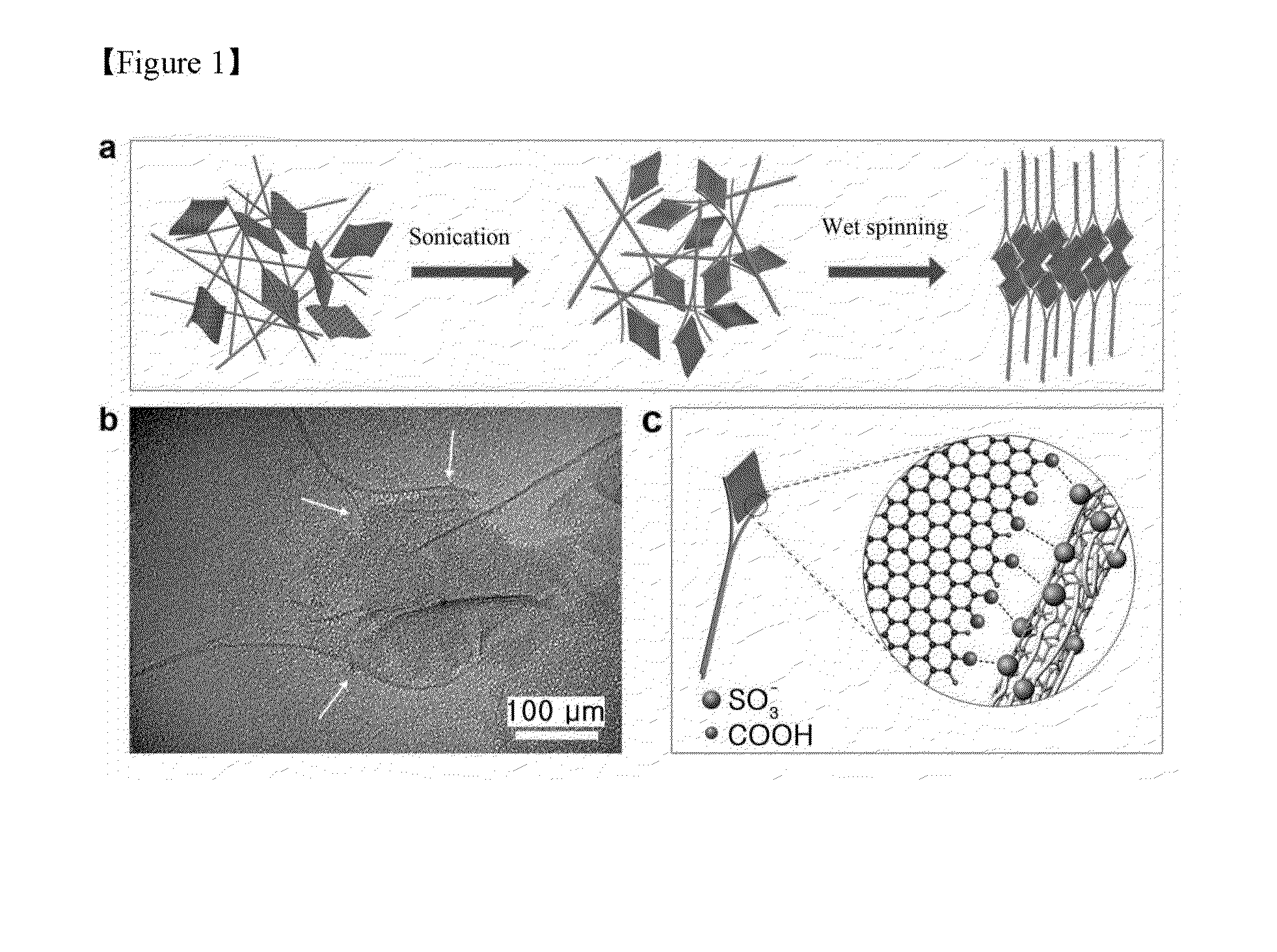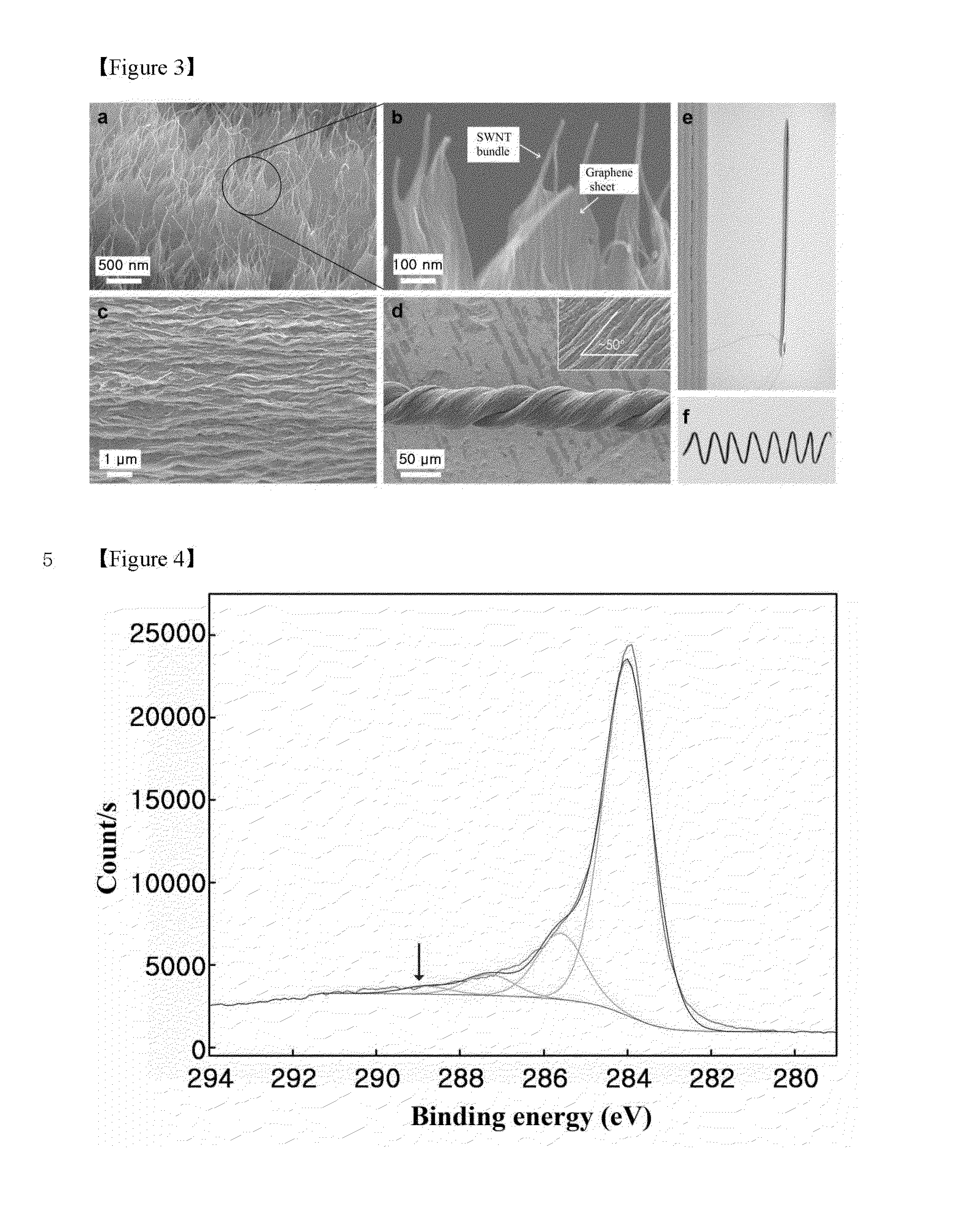Hybrid polymer composite fiber including graphene and carbon nanotube, and method for manufacturing same
a composite fiber and hybrid technology, applied in the direction of non-conductive materials with dispersed conductive materials, chemical/physical processes, textiles and paper, etc., can solve the problems of increased load transfer, uneven wrinkled surface, loss of mechanical strength, etc., and achieve the effect of high toughness
- Summary
- Abstract
- Description
- Claims
- Application Information
AI Technical Summary
Benefits of technology
Problems solved by technology
Method used
Image
Examples
example 1
Preparation of Solution of Chemically Modified Reduced Graphene (RCCG)
[0042]In accordance with the method shown in FIG. 9, RCCG was dispersed in dimethylformamide (DMF) in the presence of an appropriate amount of triethylamine to obtain a stable graphene dispersion. Several grams of RCCG was obtained by reducing an aqueous dispersion of CCG with excess hydrazine at 95° C. over 2 h in accordance with previously reported methods (Li, D., Muller, M. B., Gilje, S., Kaner, R. B. & Wallace, G. G. Processable aqueous dispersions of graphene nanosheets. Nature Nanotech. 3, 101 (2008)). As a result of the reduction reaction, the graphene aggregated in the aqueous solution. The aggregated graphene particles were acidified with dilute sulfuric acid under vigorous stirring to a pH of 2 or less, and transferred to a funnel. The aggregates were washed with a large amount of Milli-Q water on the funnel until the pH reached about 7. The filtered material was dried under vacuum at 70° C. for 48 h to...
example 2
Production of Graphene Flakes / Single-Walled Carbon Nanotubes / Polymer (GF / SWNT / PVA) Fiber
[0043]For fiber spinning, an aqueous dispersion of GFs and an aqueous dispersion of SWNTs were prepared. In order to convert a GF / DMF dispersion to the aqueous dispersion of GFs, the GFs were collected by centrifugation and the DMF supernatant was discarded. The DMF was replaced by the same volume of water, followed by sonication. This procedure was repeated three times to completely remove the DMF. Subsequently, the GFs were effectively dispersed in the water by sonication using 1 wt % sodium dodecyl benzene sulfonate (SDBS). The resulting GF aqueous dispersion was subjected to sonication using 1 wt % SDBS for 30 min and mixed with the separately prepared SWNT aqueous dispersion. The graphene / SWNT dispersion was slowly injected into a beaker containing PVA (molecular weight=146,000−186,000, degree of hydrolysis=˜99%) as a coagulant to produce a continuous, uniform GF / SWNT / PVA hybrid fiber. The f...
experimental example
Characterization of the Composite Fibers
[0045]The mechanical properties of the hybrid GF / SWNT / PVA fiber were evaluated. As a result, surprising synergistic effects were confirmed when the weight ratio of the two kinds of nanoparticles was 1:1. FIG. 2a shows typical stress-strain curves of the hybrid GF / SWNT / PVA fiber, the GF / PVA fiber, and the SWNT / PVA fiber. In each case, the PVA content was 35-40% by weight. The hybrid fiber including GFs and SWNTs in a weight ratio of 1:1 showed markedly increased fracture strength, fracture strain, and yield strength compared to the other hybrid fibers, the SWNT / PVA fiber, and the GF / PVA fiber. The moduli of elasticity of the composites steadily increased with increasing content of GF relative to SWNT (FIG. 2b). The modulus of elasticity of the GF / PVA fiber (3.6 GPa) was 3 times or more higher than that of the SWNT / PVA fiber (1.1 GPa), which demonstrates that the reinforcing effect of GFs is stronger than that of SWNTs with the same weight. The ...
PUM
| Property | Measurement | Unit |
|---|---|---|
| Temperature | aaaaa | aaaaa |
| Time | aaaaa | aaaaa |
| Percent by mass | aaaaa | aaaaa |
Abstract
Description
Claims
Application Information
 Login to View More
Login to View More - R&D
- Intellectual Property
- Life Sciences
- Materials
- Tech Scout
- Unparalleled Data Quality
- Higher Quality Content
- 60% Fewer Hallucinations
Browse by: Latest US Patents, China's latest patents, Technical Efficacy Thesaurus, Application Domain, Technology Topic, Popular Technical Reports.
© 2025 PatSnap. All rights reserved.Legal|Privacy policy|Modern Slavery Act Transparency Statement|Sitemap|About US| Contact US: help@patsnap.com



